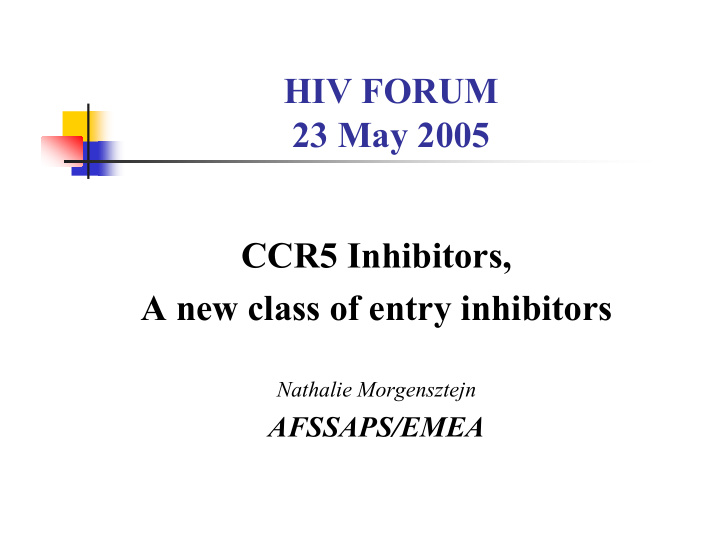



HIV FORUM 23 May 2005 CCR5 Inhibitors, A new class of entry inhibitors Nathalie Morgensztejn AFSSAPS/EMEA
New pharmacological class More questions than answers… Potential interaction with host Deleterious impact on disease progression through the shift from R5 to X4 How to deal with the phenosense limitations ? How to deal with the link between the phenosense assay and the drug development (uncertainties on its (wide) availability at the time the drug will be registered) ?
Topic already discussed at the EMEA level EMEA HIV Ad Hoc group : 8 Nov 2004 Revised HIV guideline in circulation (limited amendments => flexibility ) Comments expected until end of May 2005 Up to now no scientific advice requested by applicants for CCR5 inhibitors
SPECIFIC ISSUES IN THE DEVELOPMENT OF THESE NEW DRUGS :
PHARMACODYNAMIC SPECIFIC ISSUES CCR5 specificity (versus other human chemokine receptors such as CCR2 or CCR4) R5 occupancy
PHASE II Studies Dose selection PK/PD relationship : R5 occupancy/viral load decrease PK parameter that correlates most with efficacy ?
Naïve patients with CD4 <200 : Unsuitable target for dose selection studies (Debate raised by EATG)
Naïve patients with CD4 <200 : Potential ethical issue : Dose selection study=> implies suboptimal dose (s) => potential deleterious impact through the switch from R5 to X4 of unknown reversibility => potential negative impact in the clinical evolution Whereas there is no unmet medical need and Whereas the initial treatment is of critical importance for the long term outcome of these patients Is the inclusion of such patients compulsory in phase II studies ?
Scientific issue ? For any other drugs : reason to believe that the dose could be influenced by the sensibility of the viral strain => potential interest to explore different doses for naïve and pretreated patients For CCR5 inhibitors : reason to believe that the dose could be influenced by the R5 tropism whose indirect marker is the CD4 cell count=> potential interest to explore different doses for patients with CD4 <OR >200/mm 3
Is it compulsory to enroll such patients for dose selection (scientific issue?) How to solve the ethical and scientific issues? Topic for discussion…
Phase III studies Disputable target Population Antiretroviral experienced at advanced stage of the disease : any benefit to be expected from CCR5 antagonists => Whitcomb and al. CROI 2003
Epidemiological data (Whitcomb and al. CROI 2003) TORO 2 (Europe) TORO 1 BL RNA : 5.1 log 10 c/ml BL RNA : 5.2 log 10 c/ml BL CD4 : 98 cells/ µ l BL CD4 : 80 cells/ µ l Avg ARV drugs : 12 Avg ARV drugs : 12 >5 primary mutations ≈ 90% >5 primary mutations ≈ 80% Results were available for 612 baseline viruses : Only 2% (n=12) of viruses were non-B clade Viruses at baseline : 62 % (n=378) R5 tropic , 4 % (n=23) X4 tropic, 34 % (n=211) dual tropic ⇒ R5 tropic viruses were the most prevalent in this population of heavily pretreated patients
Inclusion/exclusion criteria Inclusion on the unique basis of VL and CD4 on CCR5 viral tropism/phenosense HIV assay Exclusion of CXCR4 and dual tropism => Potential consequence in the extrapolation of the results Importance of stratification criteria : CD4 (especially if not part of the inclusion criteria of phase III studies); T20…
No need for specific primary endpoints Antiviral agent : % of patients with undetectable viral load or VL decrease from baseline, => Surrogacy has been established => appropriate endpoints
DESIGNS TO BE CONSIDERED FOR PHASE III STUDIES ARV naïve ARV pretreated Head to head Head to head comparison / Non comparison inferiority versus an Superiority over active comparator placebo : ( Ns/tTI??, NNRTI, PI) OB +X vs OB+pboX (depends on the applicant’s expectation on the CCR5 drug’s future role in the multitherapy) Classical approaches
Need to focus on specific issues Criteria for virological failure to be clearly stated In addition to the viral load criteria, how to deal with occurrence of shift R5=>X4 : On an individual basis (double blind study) As regards the stopping rules of the study : how to define the acceptable limit in term of increased rate of shift between both treatment arms? ⇒ Critical importance of DSMB Reversibility of the shift to be substantiated Any signal on immune toxicity (increase incidence of infections)
FOLLOW-UP No amendment as regards the currently recommended follow up for approval For full approval : in naïve patients : 48 weeks In antiretroviral experienced patients : 48 weeks (=>16 weeks for conditional approval) Longer term follow-up to be planned : Theoretical risk of immunotoxicity No specific target for the follow-up but analysis of any increased risk of infection X4 shift : clinical consequence, reversibility
Phenosense HIV assay entry Two potential uses : To characterise the baseline tropism To identify the shift from R5 to X4 Critical issues : - limited performance (impact on the selected population, on the estimation of the shift)? - uncertainties on its (wide) availability at the time the drug will be registered
Conclusions Two potential risks associated with this new class : Shift from R5 to X4 : with negative impact on disease progression Deleterious impact on immune functions Importance of clear stopping rules to ensure a safe development Flexibility in the European guideline=> ultimately, balance between the benefit and the risk (risk assessment to be adapted to the emergence of any signal on toxicity during the clinical development) Limited amendments proposed on the current European HIV guidelines => awaiting for comments (end of May) …and feedback from this meeting http://www.emea.eu.int/pdfs/human/ewp/063302en.pdf
Recommend
More recommend